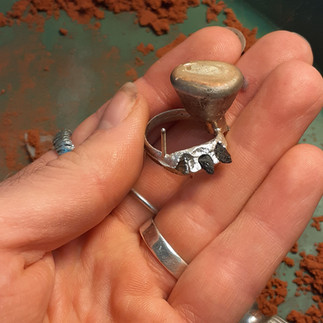Ancient Techniques: Sand Casting
Updated: Sep 1, 2022
Sand casting is an exciting and organic way of creating jewellery. The method is also known as sand moulded casting, or delft clay casting. Using sand casting we can create unique, sculptural pieces right here in the studio by hand.

We're excited to be running more sand casting classes this year at Workspace Studios in our Wellington and Christchurch locations! In this class, students can use our silver and copper or recycle their own scraps - a great way to make use of those nice offcuts!
Interest in this full day class is only growing, so hopefully next year we can fit even more dates into the calendar.
With sand casting methods we can make simple replicas of small forms, and/or create fun one-off pieces. And one great thing about it, is if we don’t like how it turned out the first time, we can re-melt and recast it again! Because we’re using sand as a temporary mould, every piece turns out a little different, and often with beautiful and unpredictable quirks and textures.
The sand cast metal technique is over a thousand years old! The Assyrian king Sennacherib (704–681 BC) was reportedly the first to have used clay molds rather than the "lost-wax" method, which is also commonly used in jewellery making to this day.
We use a special type of sand casting, called the Delft Clay method. It was created in the 80’s from extra fine sand found in the City of Delft in Holland, plus a few additives to make the sand hold together better, and retain extra detailed imprints - it would make amazing sandcastle making sand! We’re also experimenting with making our own fine sand mixes ourselves using local and natural materials!
After packing a metal or terracotta flask with the sand, we can press impressions of objects into the sand’s surface. This is usually done in two mould parts, made to match up perfectly and create more complex shapes than what is possible with only one open mould. We then melt our metal and carefully pour it into the sand mould - pry out the result with metal tongs, and voilà, a fresh piece of jewellery is formed! After casting comes the trimming, filing, sanding and polishing stages to take it from a raw piece of metal to stunning and shiny wearable jewellery.
In our classes, students can use silver, copper, or an alloy of the two, known as Shibuichi. Shibuichi is a traditional Japanese alloy, translating to mean "one-fourth" - the usual ratio of silver to copper used.

Once students are confident with the moulding and casting steps, can make it even more exciting by introducing stones to the mix. With practice, special techniques and a steady hand, precious rubies, sapphires and diamonds can be cast embedded in the metal. Now that’s where sand cast jewellery gets really fun!
Ngā mihi,
Thorn














































Comments